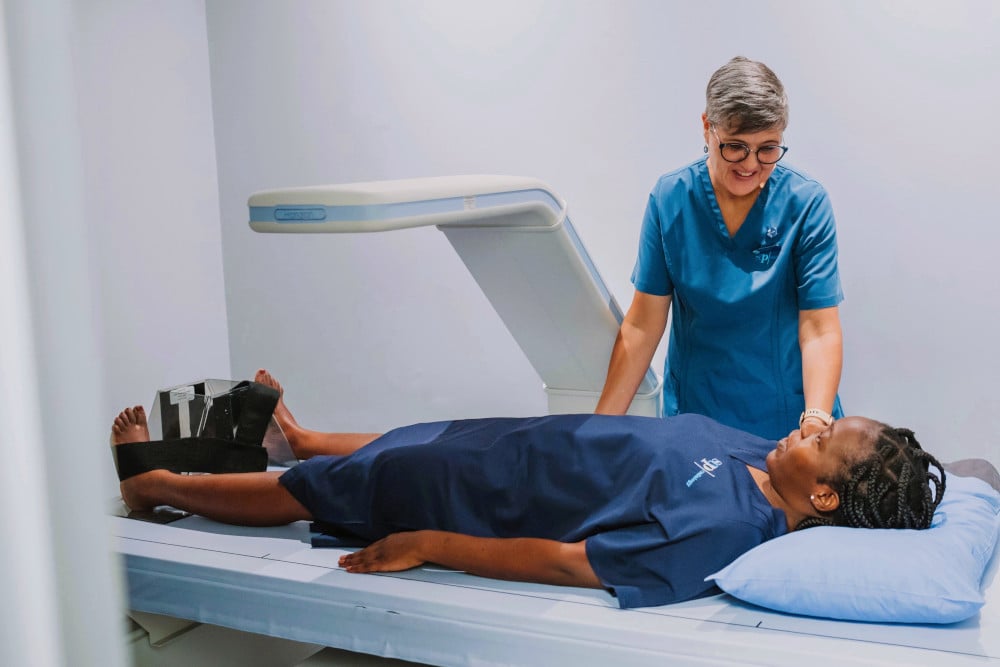Osteoporosis and bone density scans explained
In a recent interview on Cape Talk’s health and wellness segment with Pippa Hudson, radiologist Dr Vishesh Sood from SCP Radiology shared important insights into osteoporosis and the role of bone density scans in detecting and managing the condition. Osteoporosis, often dubbed the “silent disease”, is a widespread yet underdiagnosed condition affecting millions globally.
Listen to the full interview here.
Here’s a summary of their conversation, covering key aspects of the disease, its causes, and the importance of early detection through bone density scans.
What is osteoporosis?
“Osteoporosis is essentially a loss of bone mineral density,” Dr Sood explained. He likened healthy bones to a tightly packed honeycomb structure. As osteoporosis progresses, the holes within this honeycomb grow larger, and the walls become thinner, making the bones more fragile and prone to fractures. As people age, this loss of bone density accelerates, especially in those susceptible to the disease. “Bone becomes more fragile and increases the risk that patients may experience a fracture,” he said.
What causes osteoporosis?
Dr Sood pointed out that postmenopausal women are particularly at risk. “Hormonal changes, particularly the reduction of oestrogen, affect bone metabolism and turnover,” he noted. This leads to decreased bone density.
However, men aren’t immune to osteoporosis. “Men are affected to a degree as well,” Dr Sood added. Additionally, those taking steroids or certain medications for other medical conditions are also at higher risk of developing osteoporosis.
Why is osteoporosis called the “silent disease”?
The term “silent disease” often used to describe osteoporosis is no coincidence. Dr Sood explained that many people don’t know they have osteoporosis until they experience a fracture. “There are no other symptoms,” he emphasised. The absence of noticeable signs makes early detection crucial since most patients only find out after significant bone loss has already occurred.
.

.
How does a bone density scan work?
Dr Sood described the DEXA (dual-energy X-ray absorptiometry) scan as a highly accurate and non-invasive procedure that uses minimal radiation. “We use two X-ray beams to determine the density of a patient’s bone,” he said. This test allows doctors to assess whether a patient has osteopenia (early-stage bone loss) or osteoporosis (more advanced bone loss). “The test usually takes 10 to 20 minutes, and the patient simply lies comfortably while the scan is done,” he added.
The scan compares the patient’s bone density to that of a healthy young adult. Based on the results, doctors can determine the level of bone loss and make a diagnosis. It’s also a valuable tool for monitoring patients over time to gauge the effectiveness of treatment.
What does osteoporosis treatment entail?
Once osteoporosis is diagnosed, treatment options come into play. Dr Sood outlined two primary approaches: lifestyle changes and medication.
The first approach involves modifying lifestyle factors, such as adopting a diet rich in calcium and vitamin D. “Weight-bearing activities, like walking or resistance training, help strengthen bones,” he suggested. Additionally, reducing risk factors such as smoking and excessive alcohol consumption can have a positive impact.
In more advanced cases, medication may be necessary. Dr Sood highlighted hormone replacement therapy (HRT) as an option for postmenopausal women to counter oestrogen-related bone loss. There are also drugs like bisphosphonates, which help prevent the breakdown of bone.
.

.
Can osteoporosis be reversed?
Pippa asked if it’s possible to reverse osteoporosis once it’s detected. Dr Sood’s answer was cautiously optimistic. “In some cases, yes,” he said, though he acknowledged that building new bone becomes more challenging with age. However, through the combined efforts of lifestyle changes and medical treatment, it is possible to slow the progression of the disease, and in some cases, even achieve partial reversal.
Is radiation a concern?
A common concern with any form of X-ray is radiation exposure. However, Dr Sood reassured listeners that DEXA scans have a very low radiation dose. “It’s comparable to the normal background radiation you experience just going about your day at sea level,” he explained, emphasising that the risk is negligible, except for certain cases like pregnancy.
Steps to prevent osteoporosis
Dr Sood concluded the interview by outlining steps to reduce the risk of developing osteoporosis. “Maintaining a healthy, balanced diet rich in calcium and vitamin D, along with regular weight-bearing exercise, is key,” he advised. He also stressed the importance of avoiding smoking and limiting alcohol consumption.
or obtain more information about bone densitometry here. The service is available at the following SCP branches: Tygervalley Mammography Centre, Durbanville, Cape Gate, and Worcester.




